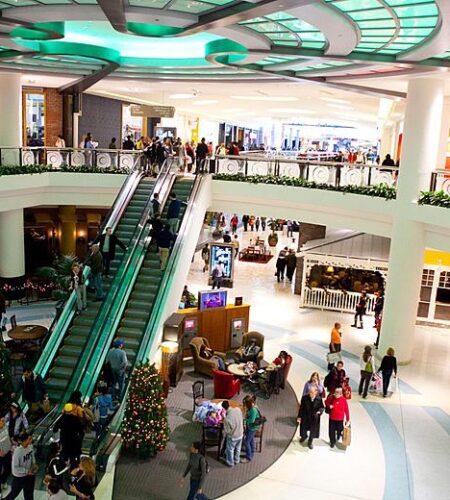(image credit: getty images)
During this decade, malls saw their heyday, bustling with activity as retailers like The Gap, Hot Topic, and Abercrombie & Fitch catered to the tastes of the era’s youth. The Gap was synonymous with classic American style, offering everything from khakis to denim jackets that defined the look of the ‘90s. With its wall of band tees and edgy accessories, Hot Topic became a beacon for those drawn to alternative music scenes, providing an oasis of counterculture in an otherwise mainstream environment.
On the other hand, Sam Goody was the ultimate destination for music lovers. At a time when physical media was king, flipping through racks of CDs and listening to new releases at the listening stations were rites of passage for many teenagers. The store’s neon signs and wall-to-wall posters created a sensory overload that made the experience of discovering new music an event in itself.
But the mall’s appeal extended beyond its individual stores. It was a self-contained universe where you could watch the latest blockbuster at the multiplex, grab a slice of Sbarro pizza, and try on outfits you’d never actually buy—all under one roof. For many, it represented freedom and independence, a place where parents could drop you off for hours, knowing you were safe but also able to explore your social world.
As the decade drew close, the mall’s dominance waned. The rise of e-commerce and the changing habits of younger generations led to a decline in foot traffic, and many iconic stores either shuttered or transformed into something unrecognizable. Empty storefronts and discount outlets replaced the once-bustling food courts and department stores, a stark reminder of how quickly cultural landscapes can shift.
Today, while some malls have reinvented themselves as entertainment complexes or lifestyle centers, the glory days of ‘90s mall culture remain a vivid memory for those who experienced it firsthand. It was a time when social interaction meant face-to-face conversations, and the height of retail therapy was walking out of The Limited with a new sweater and a sense of satisfaction that no online purchase can replicate.
The mall may have faded from its role as a cultural cornerstone, but its impact on the ’90s—and the people who came of age in that era—endures. For anyone who spent their weekends roaming the aisles of Spencer’s Gifts or sharing a giant pretzel with friends, the memory of the mall is more than a nostalgic trip; it’s a reminder of a simpler, more tangible world.


